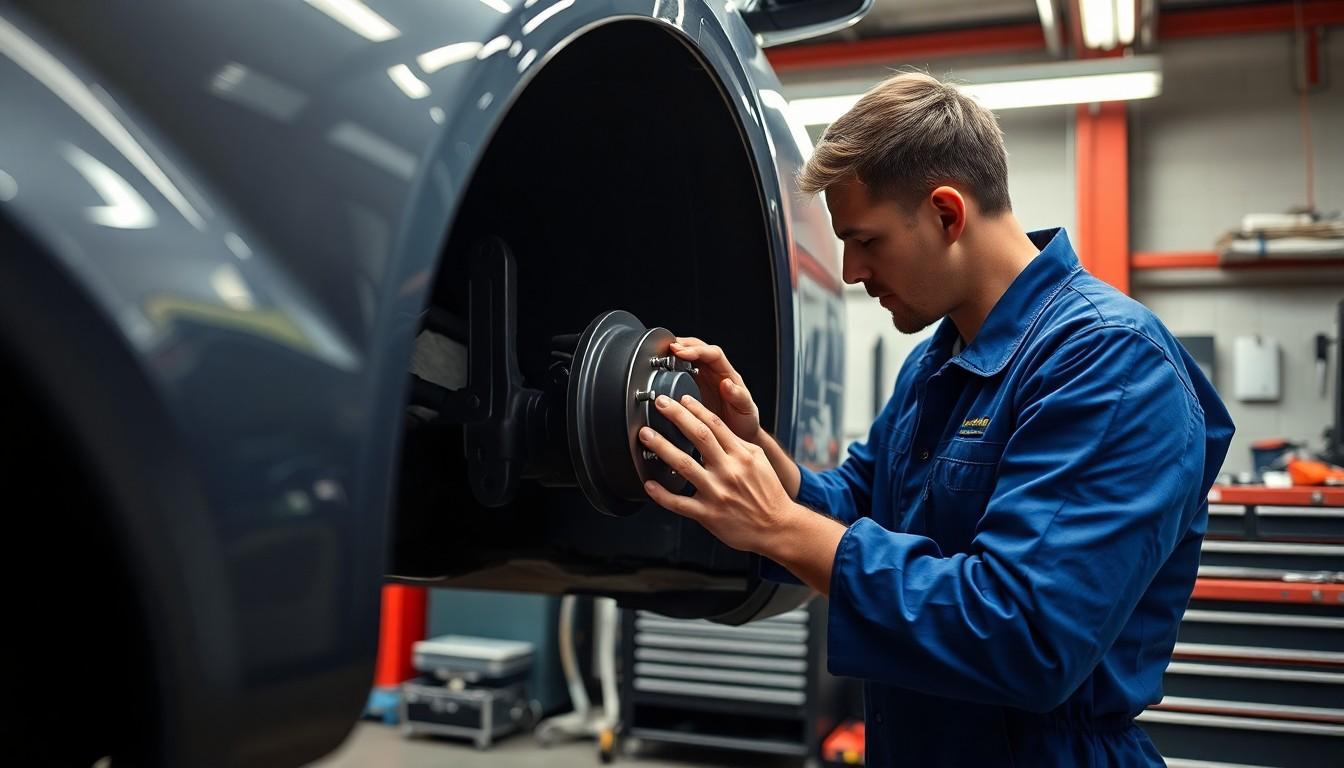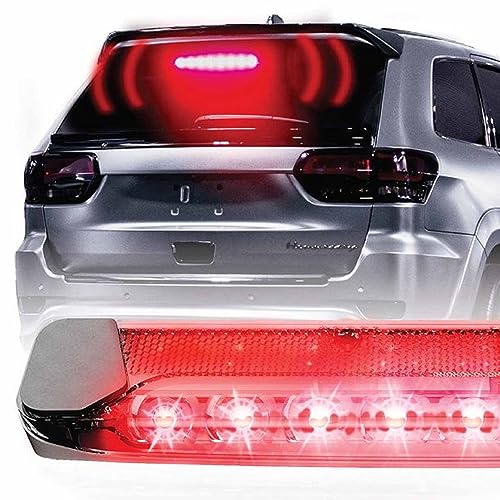Seeing your brake system warning light illuminate on the dashboard can trigger immediate concern for any driver. This red alert isn’t something to ignore—it’s your vehicle’s way of communicating a potentially serious issue that requires prompt attention.
We’ve all been there—driving along when suddenly an unfamiliar warning light appears. When it’s your brake system warning light, quick and appropriate action is essential for your safety and those sharing the road with you. In this guide, we’ll walk you through the exact steps to take when faced with this warning signal, helping you respond confidently in what could otherwise be a stressful situation.
Understanding Your Brake System Warning Light
Your vehicle’s brake system warning light isn’t just another random indicator on the dashboard—it’s specifically designed to alert you to potential problems with critical braking components. This red light typically appears as a circle with an exclamation point, the word “BRAKE,” or a similar symbol depending on your vehicle’s make and model.
The brake warning light monitors several key functions of your braking system. It illuminates when the parking brake is engaged, when brake fluid levels drop below the recommended threshold, or when there’s a potential issue with the anti-lock braking system (ABS). Many modern vehicles have separate warning lights for the ABS and the main braking system.
Brake fluid plays an essential role in your vehicle’s stopping power. It transfers the force from your foot pressing the brake pedal to the actual brake components that slow your wheels. Low brake fluid often indicates a leak in the system or worn brake pads that need replacement.
Different patterns of illumination communicate various problems. A steady light usually indicates the parking brake is engaged or brake fluid is low. A flashing light suggests a more serious malfunction in the braking system that requires immediate attention. If the light comes on while driving, it’s crucial to treat it as a safety concern rather than a minor inconvenience.
Understanding the exact meaning behind your brake warning light requires consulting your owner’s manual, which contains detailed information about your vehicle’s warning indicators. This knowledge helps you respond appropriately when the light appears and communicate effectively with your mechanic about the potential issues.
Common Reasons Why the Brake System Warning Light Illuminates

The brake system warning light activates for several exact reasons, each indicating different issues with your vehicle’s braking system. Understanding these common causes helps you address the problem quickly and ensure your safety on the road.
Low Brake Fluid Levels
Low brake fluid triggers the warning light and poses a serious safety concern. This condition often points to worn brake pads or a leak in the hydraulic system that requires immediate attention. Driving with insufficient brake fluid significantly reduces braking ability and can lead to complete brake failure in extreme cases. Regular checks of your brake fluid reservoir help prevent this situation and maintain optimal braking performance.
Engaged Parking Brake
The simplest explanation for an illuminated brake warning light is that your parking brake remains engaged. Many drivers overlook this straightforward cause when troubleshooting brake issues. Check that your parking brake is fully released before investigating more complex problems. The warning light typically turns off immediately once the parking brake is properly disengaged, allowing you to continue driving safely.
Worn Brake Pads
Brake pad sensors in many modern vehicles activate the warning light when pads wear beyond safe limits. These sensors detect when the friction material has thinned to the point where replacement becomes necessary. Your vehicle’s owner’s manual contains information about the exact warning symbols used to indicate worn brake pads. Continuing to drive with severely worn pads damages your brake rotors and creates unsafe stopping conditions.
ABS System Malfunction
ABS issues commonly trigger the brake warning light, indicating problems with this critical safety system. Faulty ABS modules, damaged wheel speed sensors, or wiring problems within the system can all activate the warning. Diagnosing these problems typically requires professional equipment to scan your vehicle’s computer for exact trouble codes. ABS malfunctions don’t necessarily prevent normal braking but do disable the anti-lock function that prevents skidding during emergency stops.
Immediate Steps to Take When Your Brake Warning Light Comes On

When your brake warning light illuminates, it’s critical to act promptly to ensure your safety. The following steps will help you address this potentially serious situation with confidence and prevent further damage to your vehicle.
Pull Over Safely
Finding a secure location to pull over is your top priority when the brake warning light comes on. Immediately locate a safe spot away from traffic, pull over completely, and turn off your engine. This precautionary measure prevents potential accidents and gives you the opportunity to assess what’s triggering the warning light without endangering yourself or others on the road.
Check Your Parking Brake
Verifying that your parking brake is fully released should be your first inspection step after pulling over. Many drivers don’t realize that a partially engaged parking brake can trigger the warning light unnecessarily. Completely disengage the parking brake and observe if the warning light turns off. This simple check often resolves the issue without requiring additional intervention or professional assistance.
Inspect Brake Fluid Levels
Examining your brake fluid reservoir is essential if the warning light remains illuminated after checking the parking brake. Locate the master cylinder (brake fluid reservoir) typically found on the driver’s side of the engine compartment and marked with minimum and maximum level indicators. Low fluid levels might indicate worn brake pads, a leak in the hydraulic system, or simply the need for additional fluid. If levels are below the minimum mark, consider adding new brake fluid—but remember to flush the old fluid first for optimal performance. Soft or spongy brake pedal response suggests air in the brake lines or a serious leak, both requiring immediate professional attention to ensure your braking system functions properly.
When to Call for Professional Help

Professional intervention is necessary when certain brake issues extend beyond simple fixes. Mechanics have specialized tools and knowledge to diagnose and repair complex brake system problems that could compromise your safety.
Warning Signs of Serious Brake Issues
Low brake fluid levels indicate potentially worn brake pads or a leak in the hydraulic system. This serious concern can result in reduced braking ability or complete brake failure if not addressed promptly. A brake pedal that sinks to the floor suggests a dangerous leak or air in the brake system, requiring immediate professional attention. ABS malfunctions, indicated by an illuminated ABS light alongside the brake warning light, demand expert diagnosis from a brake specialist. Worn brake pads triggering the brake pad warning light need replacement to prevent further damage to your braking system.
Towing vs. Driving to a Repair Shop
Arranging for a tow truck is essential if your vehicle has low brake fluid or any serious brake issues that compromise safety. Driving with compromised brakes puts you and others at risk on the road. Safe driving to a repair shop might be possible for minor issues like a slightly engaged parking brake or if brake fluid levels appear normal after checking. Even in these seemingly minor cases, we recommend having the issue checked by a professional as soon as possible. The brake system warning light indicates a potential safety concern that shouldn’t be ignored, regardless of how well the vehicle seems to be operating.
Preventative Maintenance to Avoid Brake Warning Light Issues

Regular maintenance prevents brake warning lights from activating and ensures your vehicle’s braking system remains reliable. Implementing these preventative measures helps you avoid the stress and potential danger of brake system failures on the road.
Regular Brake System Inspections
Periodic brake system inspections identify potential issues before they trigger warning lights. We recommend checking brake fluid levels monthly by locating the master cylinder reservoir and ensuring the fluid sits between the minimum and maximum markings. Inspect brake pads for wear during tire rotations, typically every 5,000-7,000 miles, looking for any signs of thinning material or unusual noises when braking. Test your parking brake functionality regularly by captivating it on a slight incline to confirm it holds the vehicle securely. These simple inspections can catch developing problems early, preventing more serious brake system failures.
Replacing Worn Components
Timely replacement of worn brake components prevents warning light activation and maintains optimal braking performance. Brake pads require replacement when they’re worn down to minimum thickness (typically 3-4mm), as sensors in many modern vehicles trigger the warning light when pads reach critical wear levels. Brake fluid should be flushed and replaced every 2-3 years regardless of appearance, since contaminated fluid compromises hydraulic pressure even if levels seem adequate. Brake lines and hoses need inspection for cracks, leaks, or corrosion during regular maintenance appointments, as damaged lines directly impact hydraulic pressure and can trigger warning lights. By addressing these components proactively rather than reactively, you’ll maintain better braking performance and avoid unexpected brake system warning lights.
Conclusion
When that brake warning light illuminates your dashboard it demands swift action. Prioritize safety by pulling over and checking your parking brake and fluid levels. For anything beyond these simple checks trust the professionals.
Remember that preventative maintenance is your best defense against brake system failures. Regular inspections coupled with timely component replacements will keep your vehicle stopping safely and effectively.
Don’t gamble with your safety or the safety of others. A properly functioning brake system isn’t just about avoiding warning lights—it’s about ensuring you can stop when you need to. Taking immediate action when warning signs appear is always the right choice.
Frequently Asked Questions
What does the brake system warning light look like?
The brake system warning light typically appears as a red circle with an exclamation point or the word “BRAKE” depending on your vehicle’s make and model. It’s designed to be easily noticeable on your dashboard to alert you to potential braking system issues that require immediate attention.
Why is my brake warning light on?
Your brake warning light could be on due to several reasons: low brake fluid levels, an engaged parking brake, worn brake pads, or ABS system malfunctions. Each of these issues varies in severity, but all require attention to ensure your vehicle’s braking system functions properly and safely.
Is it safe to drive with the brake warning light on?
No, it’s not safe to drive with the brake warning light illuminated. This warning indicates a potentially serious issue with your braking system that could compromise your ability to stop safely. Pull over when it’s safe to do so, assess the situation, and seek professional help if you can’t identify and fix a simple cause like an engaged parking brake.
How do I check my brake fluid level?
To check your brake fluid level, locate the master cylinder reservoir under the hood (consult your owner’s manual for the exact location). The reservoir is usually translucent with minimum and maximum markings. Ensure the fluid level is between these marks. Low fluid could indicate worn brake pads or a leak in the hydraulic system.
What should I do when my brake warning light comes on while driving?
When your brake warning light illuminates while driving, safely pull over as soon as possible. Check if your parking brake is fully released, then inspect your brake fluid level. If the parking brake is released and fluid levels are normal, it’s best to call for professional assistance rather than continuing to drive.
How often should I have my brakes inspected?
Have your braking system professionally inspected every 10,000-12,000 miles or at least once a year. Additionally, perform monthly visual checks of your brake fluid level and inspect brake pads during tire rotations. Regular maintenance helps prevent unexpected brake failures and warning light activations.
Can I just add more brake fluid if the level is low?
While you can add brake fluid if levels are low, it’s important to understand that low fluid is often a symptom of another issue, such as worn brake pads or a leak in the hydraulic system. Adding fluid may temporarily resolve the warning light, but the underlying problem should be diagnosed and fixed by a professional.
What’s the difference between the brake warning light and the ABS light?
The brake system warning light (typically red) indicates issues with the primary braking system, like low fluid or engaged parking brake. The ABS light (usually yellow) specifically signals problems with the Anti-lock Braking System. If both lights are on simultaneously, this indicates a serious issue requiring immediate professional attention.
How much does it cost to fix brake warning light issues?
The cost to fix brake warning light issues varies widely depending on the cause. Simple fixes like releasing the parking brake cost nothing, while brake pad replacement typically runs $150-$300 per axle. Major repairs involving the master cylinder or ABS system can cost $300-$1,000+. Early attention to warning lights often prevents more expensive repairs.
How can I prevent brake system warning light issues?
Prevent brake system warning light issues through regular maintenance: check brake fluid monthly, inspect brake pads during tire rotations, test your parking brake regularly, and replace worn components promptly. Also, respond to any changes in braking performance immediately and follow your vehicle’s recommended maintenance schedule for brake fluid replacement.









